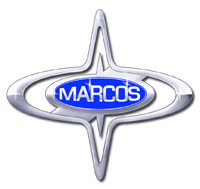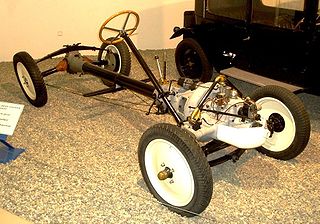
The Triumph Motor Company was a British car and motor manufacturing company in the 19th and 20th centuries. The marque had its origins in 1885 when Siegfried Bettmann of Nuremberg formed S. Bettmann & Co. and started importing bicycles from Europe and selling them under his own trade name in London. The trade name became "Triumph" the following year, and in 1887 Bettmann was joined by a partner, Moritz Schulte, also from Germany. In 1889, the businessmen started producing their own bicycles in Coventry, England.

Marcos Engineering was a British sports car manufacturer. The name derives from the surnames of founders Jem Marsh and Frank Costin.
Westfield Sportscars is a manufacturer of both factory built and kit versions of several two-seater, open top sportscars. Their main product is a Lotus Seven inspired car – vehicles originally designed by Colin Chapman with only the bare essentials for motoring in order to give the rawest and most exhilarating driving experience.

Ashley were manufacturers of body shells and chassis for specials from 1955 to 1962. They also offered a range of products for special builds: radiators, header tanks, lighting sets, steel tubing, sheet aluminium, various suspension parts, water pumps, tires, tubes and wheels. The company also made bonnets and hardtops for other mass-produced sports cars, including the Austin-Healey Sprite and Jaguar E-Type.

The Triumph Spitfire is a British sports car manufactured over five production iterations between 1962 and 1980. Styled for Standard-Triumph in 1957 by Italian designer Giovanni Michelotti, the Spitfire was introduced at the London Motor Show in 1962. It was manufactured at the Standard-Triumph Canley works, with approximately 315,000 produced over 18 years.
Sharps Commercials Ltd was a British car maker based in Preston, Lancashire. It was founded in 1922 by Paul Sharp. It changed its name to Bond Cars Ltd in 1963. The company was taken over by the Reliant Motor Co Ltd of Tamworth, Staffordshire in February 1969, who eventually closed the Preston factory at the end of July 1970, transferring the spare parts business for the Bond Minicar, 875 saloon, 875 Ranger van and Equipe models to a firm called Bob Joyner & Son in Oldbury in the English Midlands. Reliant nevertheless continued to use the Bond name until 1974 on Bond Bug models made at their own Tamworth plant.

The Triumph Herald is a small two-door car introduced by Standard-Triumph of Coventry in 1959 and made through to 1971. The body design was by the Italian stylist Giovanni Michelotti, and the car was offered in saloon, convertible, coupé, estate and van models, with the latter marketed as the Triumph Courier.

Fairthorpe Ltd was a British manufacturer of motorcars, active between 1954 and 1973. Production was in Chalfont St Peter, Buckinghamshire, England between 1954 and 1961, from 1961 to 1973 in Denham, Buckinghamshire.

Locust is a kit car inspired by the Lotus Seven. It was first developed in the mid 1980s as a cheap kit car to be built onto the chassis of a Triumph Spitfire, it was later developed into a full kit car which used its own fully designed ladder chassis - unlike others using space frame. The car was famed for its cheap to build construction using marine ply for the body, which was then covered with aluminium sheeting, the last kits were produced in early 2000.

Falcon Shells was a British company that produced specials/kit cars from 1956 until 1964.
Sylva Autokits is a kit car manufacturer based in Lincolnshire, England. Sylva was founded in 1981 by Jeremy Phillips and has developed and produced a number of small and lightweight sports cars. Sylva cars have won a number of 750 Motor Club Kit Car championships.

JC Midge is a hand built car i.e. a "plan and pattern" car designed by John Cowperthwaite. Like the Locust the body is made of aluminium skinned plywood or MDF and using a purpose made grille or one from a donor, such as a Wolseley 1500. Unlike a Kit car only a few parts were available, the rest being from the donor car or hand made by the builder by sticking paper patterns on plywood or aluminium and cutting round them with a jigsaw. The starting point was a set of patterns and instructions costing £35 and the designer claimed it was possible to put a car on the road for £800.

Backbone tube chassis is a type of automobile construction chassis that is similar to the body-on-frame design. Instead of a two-dimensional ladder-type structure, it consists of a strong tubular backbone that connects the front and rear suspension attachment areas. A body is then placed on this structure. It was first used in the English Rover 8hp of 1904 and then the French Simplicia automobile in 1909.

The Bond Equipe is an English 2+2 sports car, manufactured by Bond Cars Ltd from 1963 to 1970. It was the first 4-wheeled vehicle from Bond Cars.

The GTM Coupé is a Mini based kit car dating back to 1967. GTM is an initialism for "Grand Touring Mini". The car was first shown at the 1967 Racing Car Show and soon afterwards went into production by the Cox brothers from their garage in Hazel Grove, Stockport as the Cox GTM. In 1969 the rights to the design and manufacturing were bought by Howard Heerey and the Cox part of the name was dropped. Heerey's father's company, Midland Garage, took over manufacture of the GTM. In April 1980 ownership changed again to GTM Engineering, who upgraded and continued to manufacture the Coupé until 1995.

Burlington Cars was a British kit car company originally based in Leamington Spa, Warwickshire. They moved to Northampton in 1988 becoming the Burlington Motor Company reforming as the Burlington Design Group in 1989. Kit production seems to have stopped in around 1992. Founded by Haydn Davis the cars were at first of the "plan and pattern" car) type similar to the JC Midge. Like the Midge it uses a Triumph donor and constructs a body of plywood on top of it, i.e. a body-on-frame design.
Henry George Webster, CBE was a British automotive engineer. He is best known for his work at the Triumph Motor Company throughout the 1950s and 1960s.

Spice Engineering was a British racing team founded by driver Gordon Spice with Raymond Bellm in the early 1980s, later becoming a successful sports car constructor in 1986. They competed in the World Sportscar Championship in Europe as well as the IMSA GT Championship in North America, at times partnering with major manufacturers such as General Motors and Honda as well as race engine manufacturer Comptech.

Marlin is a British sports car manufacturer founded in 1979 in Plymouth as Marlin Engineering and now located in Crediton, Devon, England.

The Triumph Fury is a prototype two-door drophead coupé commissioned by the Standard-Triumph Company of Coventry, England. It was the first Triumph sports car built on a unitary construction platform.



















